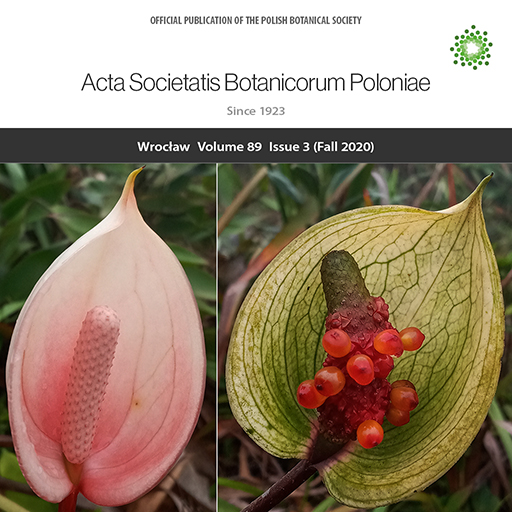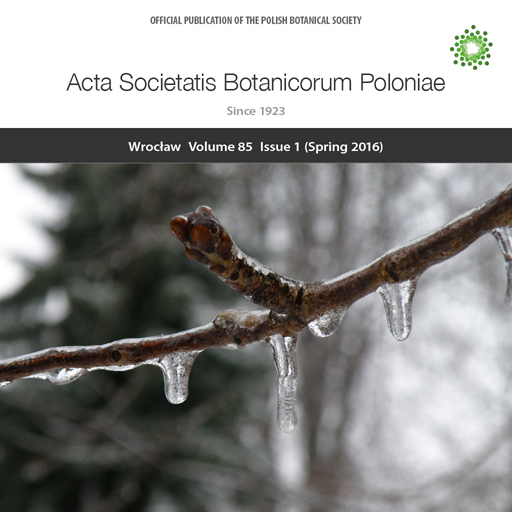2022
Vol 91 (2022)
On the cover Fern gametophytes recovered after storage in liquid nitrogen (−196 °C), breaking through alginate cover, demonstrate how strong potential of life is, enabling to survive even in extremely harsh environmental conditions.
[Author: Anna Mikuła]
2021
Vol 90 (2021)
On the cover Plant predator and its prey – Microscopic view of the mistletoe haustorium invading secondary xylem of poplar.
[Author: Magdalena Turzańska]
2020
Vol 89, No 4 (2020)
On the cover Longing for spring greenery – A botanical riddle.
[Author: Beata Zagórska-Marek]
Vol 89, No 3 (2020): Recent Developments in Taxonomy and Phylogeny of Plants
On the cover Anthurium lasabanteaense Croat & O. Ortiz (Araceae), an endemic species from Panama. Location: Veraguas Province: Santa Fe National Park, La Sabaneta. Voucher specimen: tropical savanna with elfin cloud forest fragments, 08°40’95” N, 80°59’25” W, 1,225 m, July 7, 2020, Juvenal Batista 2001 (PMA). Left: Inflorescence with white spathe tinged pink and a pinkish cylindroid flowering spadix. Right: Infructescence, greenish white spathe with darker green venation and fruiting spadix with red-orange berries. Note: Anthurium species often have dramatic changes in the aspect, color or disposition of the different parts of the inflorescence owing to their different functions, i.e. attracting pollinators (usually bees) in flowering stage and attracting dispersers (usually birds) during fruiting stage.
[Author: J. Batista]
Vol 89, No 2 (2020)
On the cover Dormiunt vigilant: the majestic dead oak giants of Rogalinek in the Warta River Valley see to their end looking at the sunset.
[Author: Piotr Kiciński]
Vol 89, No 1 (2020)
On the cover Picea abies – crystalline apex, isolated from winter bud, displays sheer beauty of phyllotaxis. New findings show that plant controls strictly its chirality in the laterals of branching shoot (see inside the issue). The apex unusual feature is chlorophyll distribution pattern exposed by the pigment’s red autofluorescence. Chlorophyll is present in the cells of the apical dome (center), absent in the youngest leaf primordia and emerges gradually as they age.
[Author: Magdalena Turzańska]
2019
Vol 88, No 4 (2019)
On the cover Flowering Arnica montana L. stand from the Knyszyn Forest.
[Author: Piotr Sugier]
Vol 88, No 3 (2019)
On the cover Flowering Rhododendron ferrugineum in the Sowia Dolina (Karkonosze Mts). Nearest populations of this species are known from Austrian Alps. It is, therefore, the northernmost and most isolated population of this subalpine and glacial relict shrub described so far.
[Author: Marek Malicki]
Vol 88, No 2 (2019)
On the cover Pine forest floor under the nests of grey heron is white stained by guano (uric acid). Together with dead nestlings (right corner) falling accidentally out of the nests guano increases the nitrogen level in a soil making locally the environment of the forest quite specific.
[Author: Joanna Czarnecka]
Vol 88, No 1 (2019)
On the cover Grasslands in the landscape of Poland. The map shows distribution of grasslands, and the photographs show different types of grasslands: sandy dry grassland with Corynephorus canescens, lowland hay meadow (Arrhenatheretalia elatioris), Molinia meadow, subalpine grassland with Nardus stricta, and seminatural dry grassland (Festuco-Brometea).
[Authors: Magdalena Szymura and Tomasz Szymura]
2018
Vol 87, No 4 (2018): Polar terrestrial ecosystems: ecology, diversity, and biogeography
On the cover Dry heaths dominated by white-flowering Dryas octopetala, an ecologically important arctic-alpine dwarf shrub, extend here and there in the west coast of Spitsbergen. This photo shows a shore of Adventfjorden bay in a region of the largest ice-free areas in the Svalbard archipelago – the most intensely studied in the high Arctic.
[Author: Michał Ronikier]
Vol 87, No 3 (2018)
On the cover The specimen of Dicranum polysetum Sw. from S. B. Gorski‘s bryophyte collection in the Herbarium of Vilnius University (WI). It was collected in 1834 in the forest surrounded by the Neris River (currently the Vingis Park, Vilnius). Stanisław Batys Gorski (1802–1864) was a pharmacist, botanist, and entomologist. His bryological collection in WI contains 729 specimens. This is probably a part of the collection described in Gorski‘s manuscript as “Herbarium generale Polonicum et Lithuanicum”. It also includes the material collected or received by exchange during Gorski’s travels to Central and Southern Europe. In 2016, the collection was reassembled and revised.
[Author: Mindaugas Rasimavičius]
Note from the Editor The correct name of this great naturalist and collector is Stanisław Batys Górski. It can be seen in his handwriting on the photograph dedicated to his colleague Józef Warszewicz (Köhler 2014, Acta Baltica Historiae et Philosophiae Scientiarum Vol. 2, No. 1, DOI: 10.11590/abhps.2014.1.02). The commonly used version of the last name: Gorski, is simplified.
Beata Zagórska-Marek
Vol 87, No 2 (2018)
On the cover Magnolia obovata Thunb. In this particular flower, calyx phenotype (green tissue) is limited to the sector of the sepal otherwise expressing a corolla phenotype. It implies chimeric character of floral genes expression patterns. A progressive trait of perianth differentiation in some magnolias has been recently confirmed by molecular-genetic studies.
[Author: Beata Zagórska-Marek]
Vol 87, No 1 (2018)
On the cover Cinnamomum camphora Ness et Eberm. – transverse section through the young stem exposes the surface of the cut to the air. This in seconds induces the appearance of a deep red stain but only in cambial cells and their youngest phloem derivatives. The nature of this natural reaction is not known.
[Author: Beata Zagórska-Marek]
2017
Vol 86, No 4 (2017)
On the cover Lateral branch of Wollemia nobilis W. G. Jones, K. D. Hill & J. M. Allen terminating in a male cone. The tree is a hero of fantastic story telling how the Jurassic gymnosperm became an extant plant. Now recommended as a new Christmas tree. This specimen, grown outdoors near Wrocław town in Lower Silesia, Poland, produced many cones last summer, but had to be moved indoors for the winter.
[Author: Beata Zagórska-Marek]
Vol 86, No 3 (2017)
On the cover The oldest field maple (Acer campestre L.) in Poland. It grows in the park which surrounds the mansion erected in fifteenth century by the members of Dobrzycki noble family, in Dobrzyca (Great Poland Province). Planted in 1680 measures 637 cm in girth. It is protected by law as the Monument of Nature No. 240.
[Author: Beata Zagórska-Marek]
Vol 86, No 2 (2017)
On the cover The inner life of the leaf. Formation of the hairy gall in the beech leaf by the gall midge Hartigiola annulipes (Diptera, Cecidomyiidae): the early stage (left) and the fully developed gall (right).
[Author: Edyta Gola]
Vol 86, No 1 (2017)
On the cover Regardless of who I am: Anemone or Hepatica, I announce with my heavenly blue that the spring has come to the woodlands.
[Author: Beata Zagórska-Marek]
2016
Vol 85, No 4 (2016): Phyllotaxis and related topics
On the cover A computer simulation of phyllotactic transition frequent in the main axes of dicotyledonous plants and in lateral shoots of conifers. Rectangular simulation space represents the split-open surface of cylindrical shoot, stacked disks – the primordia of lateral organs. The initial 2:2 decussate phyllotaxis (GREEN DOMAIN) transforms into 2:3 helical one (BLUE DOMAIN) through addition of one parastichy inclined to the left (γ-dislocation). This is due to quite rapid, yet continuous decrease in the size of primordia (RED DOMAIN), changing their identity from cotyledons or prophylls (GREEN) to the leaf proper (BLUE).
[Author: Beata Zagórska-Marek]
Vol 85, No 3 (2016)
On the cover Fireworks in the plant world – vascular bundles in Selaginella kraussiana labeled with Texas Red.
[Author: Edyta M. Gola]
Vol 85, No 2 (2016)
On the cover Autofluorescence of chlorophyll in two chloroplasts of unicellular green alga Netrium sp. (Zygnematales). Their elaborate shapes with deep ridges giving stellate appearance in cross-section of the cell, have been visualized here by using focus stacking technique.
[Author: Magda Turzańska]
Vol 85, No 1 (2016)
On the cover Winter’s good-bye – a cherry tree in the orchard wearing the lace of icicles.
[Author: Beata Zagórska-Marek]
2015
Vol 84, No 4 (2015)
On the cover Remembering summer roses – bright and beautiful winter flowers of Camellia sasanqua Thunb.; the plant, native to Japan, grows there in the mountains high, but also in the gardens, where it blossoms till February, often under the cover of a white snow; its evergreen shiny leaves are used for making tea.
[Author: Beata Zagórska-Marek]
Vol 84, No 3 (2015)
On the cover The swallowtail butterfly (Papilio machaon L.) studying the mysteries of wild teasel inflorescence (Dipsacus fullonum L.). The first one is bijugate phyllotaxis emerging typically from the initial decussate one. The second is bi-directional blooming, which starts from the equatorial area of the inflorescence. The regulatory mechanism of this peculiar behavior remains unknown.
[Author: Beata Zagórska-Marek]
Vol 84, No 2 (2015)
On the cover Clematis ×jackmanii Moore – aberrant flower with the symptoms of meristic variation in the region of perianth. In addition, one half the tepal seen in a front (discolored) is a mosaic of the cell clones having different identities – of a tepal and of a leaf.
[Author: Beata Zagórska-Marek]
































